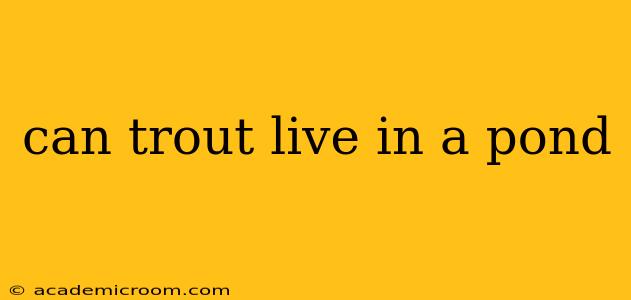Can Trout Live in a Pond? A Deep Dive into Trout Habitat
The simple answer is: sometimes, but it's challenging. Trout are notoriously picky about their environment, and while they can technically survive in a pond, thriving is a different story. Several factors determine whether a pond is suitable for trout, and understanding these factors is crucial for anyone considering introducing them to a pond environment.
What kind of pond is best for trout?
This is a critical question. Not all ponds are created equal. Trout require specific conditions to survive and flourish, making the suitability of a pond highly dependent on several key characteristics. The ideal pond for trout will possess:
-
Sufficiently Cold Water: Trout are cold-water fish. Their ideal temperature range is generally between 45-65°F (7-18°C). Ponds in warmer climates or those with shallow, sun-baked areas are unlikely to provide the consistently cool temperatures trout need. A deep pond with a reliable source of cool, spring-fed water is best.
-
High Oxygen Levels: Trout need well-oxygenated water. Stagnant, nutrient-rich ponds often have low oxygen levels, leading to stress and potentially death for trout. A well-maintained pond with proper aeration and a healthy aquatic plant balance is crucial.
-
Clear Water: Trout rely on their vision to hunt. Muddy or excessively cloudy water significantly impairs their ability to find food, leading to poor growth and health.
-
Appropriate Size and Depth: A pond needs to be sufficiently large to support a trout population without overcrowding. The depth is important for providing thermal stratification and refuge during hot summer months. A larger, deeper pond offers more stable conditions.
-
Suitable Substrate: Trout prefer a substrate consisting of gravel, rocks, and sand. This provides them with hiding places and suitable spawning areas. A muddy or silty bottom is less ideal.
-
Absence of Predatory Fish: Introducing trout into a pond already containing larger predatory fish, such as bass or pike, is virtually guaranteed to result in the trout being eaten.
What are the challenges of keeping trout in a pond?
Even in an ideal pond, keeping trout can be challenging. Several factors can impact their survival and well-being:
-
Disease: Trout are susceptible to various diseases and parasites. Maintaining good water quality and avoiding overcrowding can help prevent disease outbreaks.
-
Water Temperature Fluctuations: Sudden changes in water temperature, especially during hot spells, can stress trout and even lead to mortality.
-
Food Supply: Providing a sufficient and appropriate food supply is essential for trout growth. This often involves supplementing their natural food sources with commercially available trout feed.
-
Competition: Other fish species present in the pond might compete for resources and space, affecting trout growth and survival.
Can I stock trout in my existing pond?
Whether you can successfully stock trout in your existing pond depends entirely on the characteristics of your pond. Carefully assess your pond's water temperature, oxygen levels, clarity, size, depth, substrate, and existing fish populations before making any decisions. It is highly recommended to consult with a local fisheries expert or pond management professional. They can provide you with expert advice tailored to your specific pond conditions.
How do I create a trout pond?
Creating a pond suitable for trout requires careful planning and execution. This involves selecting an appropriate site, managing the water flow and quality, creating suitable habitat, and implementing measures to maintain water temperature and oxygen levels. Building such a pond is a significant undertaking requiring expertise in pond construction and aquatic ecology.
In summary, while trout can live in a pond, it's a complex undertaking that requires careful planning, ongoing maintenance, and a deep understanding of trout's specific needs. It's not a casual endeavor; success hinges on providing a consistently suitable environment that mimics their natural habitat.
